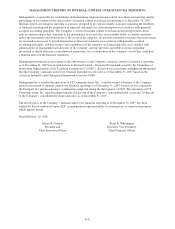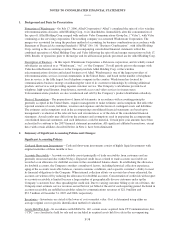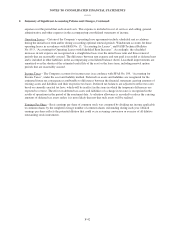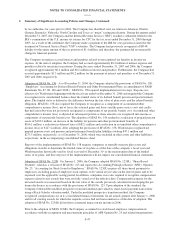Windstream 2007 Annual Report Download - page 124
Download and view the complete annual report
Please find page 124 of the 2007 Windstream annual report below. You can navigate through the pages in the report by either clicking on the pages listed below, or by using the keyword search tool below to find specific information within the annual report.
NOTES TO CONSOLIDATED FINANCIAL STATEMENTS
1. Background and Basis for Presentation:
Formation of Windstream – On July 17, 2006, Alltel Corporation (“Alltel”) completed the spin off of its wireline
telecommunications division, Alltel Holding Corp., to its shareholders. Immediately after the consummation of
the spin off, Alltel Holding Corp. merged with and into Valor Communications Group Inc. (“Valor”), with Valor
continuing as the surviving corporation. The resulting company was renamed Windstream Corporation. The
merger was accounted for using the purchase method of accounting for business combinations in accordance with
Statement of Financial Accounting Standards (“SFAS”) No. 141 “Business Combinations”, with Alltel Holding
Corp. serving as the accounting acquirer. The accompanying consolidated financial statements reflect the
combined operations of Alltel Holding Corp. and Valor following the spin off and merger transactions on July 17,
2006. Results of operations prior to the merger and for all historical periods presented are for Alltel Holding Corp.
Description of Business – In this report, Windstream Corporation, a Delaware corporation, and its wholly owned
subsidiaries are referred to as “Windstream”, “we”, or “the Company”. For all periods prior to the merger with
Valor described herein, references to the Company include Alltel Holding Corp. or the wireline
telecommunications division and related businesses of Alltel. Windstream is one of the largest providers of
telecommunications services in rural communities in the United States, and based on the number of telephone
lines in service, is the fifth largest local telephone company in the country. Windstream has focused its
communications business strategy on enhancing the value of its customer relationships by offering additional
products and services and providing superior customer service. The Company’s subsidiaries provide local
telephone, high-speed Internet, long distance, network access and video services in sixteen states.
Telecommunications products are also warehoused and sold by the Company’s product distribution subsidiary.
Basis of Presentation – The preparation of financial statements, in accordance with accounting principles
generally accepted in the United States, requires management to make estimates and assumptions that affect the
reported amounts of assets, liabilities, revenues and expenses and disclosure of contingent assets and liabilities.
The estimates and assumptions used in the accompanying consolidated financial statements are based upon
management’s evaluation of the relevant facts and circumstances as of the date of the consolidated financial
statements. Actual results may differ from the estimates and assumptions used in preparing the accompanying
consolidated financial statements, and such differences could be material. Certain prior year amounts have been
reclassified to conform to the 2007 financial statement presentation. All significant affiliated transactions, except
those with certain affiliates described below in Note 2, have been eliminated.
2. Summary of Significant Accounting Policies and Changes:
Significant Accounting Policies
Cash and Short-term Investments – Cash and short-term investments consist of highly liquid investments with
original maturities of three months or less.
Accounts Receivable – Accounts receivable consist principally of trade receivables from customers and are
generally unsecured and due within 30 days. Expected credit losses related to trade accounts receivable are
recorded as an allowance for doubtful accounts in the consolidated balance sheets. In establishing the allowance
for doubtful accounts, the Company considers a number of factors, including historical collection experience,
aging of the accounts receivable balances, current economic conditions, and a specific customer’s ability to meet
its financial obligations to the Company. When internal collection efforts on accounts have been exhausted, the
accounts are written off by reducing the allowance for doubtful accounts. Concentration of credit risk with respect
to accounts receivable is limited because a large number of geographically diverse customers make up the
Company’s customer base, thus spreading the credit risk. Due to varying customer billing cycle cut-off times, the
Company must estimate service revenues earned but not yet billed at the end of each reporting period. Included in
accounts receivable are unbilled receivables related to communications revenues of $21.0 million and
$33.5 million at December 31, 2007 and 2006, respectively.
Inventories – Inventories are stated at the lower of cost or market value. Cost is determined using either an
average original cost or specific identification method of valuation.
Assets Held For Sale – In accordance with SFAS No. 142, certain assets acquired from CT Communications, Inc.
(“CTC”) are classified as held for sale and are included in acquired assets held for sale in the accompanying
F-38
























